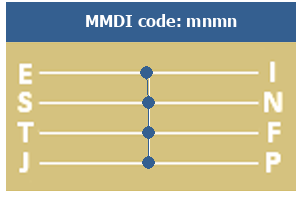Personality Profiles

There is no data to produce your personality profile. Please complete the MMDI questionnaire or choose your own results. When we have your results, we will be able to update the diagram with your unique personality profile. It shows the MMDI results in terms of your personal balance of preferences on four dimensions of personality. When the blue dot is close to the middle, you like to use both styles in equal measure. The closer the blue dot is to one side, the more you prefer to use that style than the other.
Preferences
There are three main ways of looking at your personality - as preferences on four dimensions, closeness to sixteen stereotypes, and as the dynamic interaction of psychological functions and attitudes. When you have completed the questionnaire, the scores that show the balance of your preferences will appear below.
| E I | Extraversion involves interacting with people, taking an interest in broad topics, and tending to act first then think. Introversion involves concentrating on a few, deep issues, and thinking things through before acting. |
| S N | Sensation looks at facts, takes a practical approach and tends to be interested in clear, detailed information. Intuition looks at potential and possibilities, and tends to be interested in what is not yet known. |
| T F | Thinking involves using principles, taking a detached, objective view as an onlooker, analysing and criticising. Feeling involves using values, taking a personal, subjective view as a participant, valuing and appreciating. |
| J P | Judgment structures and controls life, making decisions and establishing closure or stability. Perception retains flexibility, inquiring, being spontaneous, keeping options open and waiting to see what develops. |
Stereotypes
Another way to look at your personality is in terms of its closeness to 16 stereotypes. This is like using landmarks on a map to identify your unique location.
When you have completed the questionnaire, a table will appear here that shows the closeness of your unique personality to each of 16 personality types. Your personality can change over time, and particularly so during midlife and beyond. The questionnaire provides a snapshot of your current personality.
Personality dynamics
In personality type theory, there are four basic typological (psychological) functions that everyone has, but use in different ways, and one advanced function, the 'transcendent function'. When you have completed the questionnaire, your current type dynamics will be represented here by your mental muscle diagram.